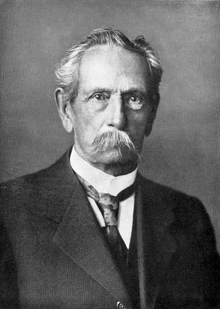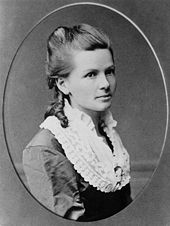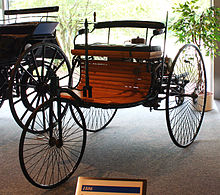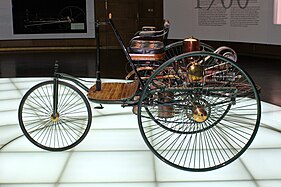Carl Benz
Carl Friedrich Benz (born November 25, 1844 in Mühlburg as Karl Friedrich Michael Vaillant , † April 4, 1929 in Ladenburg ) was a German engineer and automobile pioneer . His Benz Patent Motor Car No. 1 from 1885 is considered the first practical automobile . On January 29, 1886, he applied for a patent for his motor vehicle.
From his mechanical engineering and automotive company Benz & Cie. was created in 1926 through the merger with Daimler-Motoren-Gesellschaft , the Daimler-Benz AG (now Daimler AG ).
Life
origin
Carl Benz was born out of wedlock as Karl Friedrich Michael Vaillant on November 25, 1844 in the city of Mühlburg (today a district of Karlsruhe ) . The name Karl Friedrich Michael Wailand was accidentally entered in the church register of the evangelical parish of Mühlburg . His parents were the Karlsruhe maid Josephine Vaillant and the locomotive driver Johann Georg Benz, born in 1809 . The mother was Protestant, the father Catholic. Johann Georg Benz came from Pfaffenrot (today the municipality of Marxzell ), where his ancestors had operated a forge for generations . He worked for the Baden Railway .
According to the church register, the baptismal witnesses were the "citizen, host and brewer" Michael Kramer from Mühlburg and the master shoemaker Karl Axtmann from Karlsruhe, whose ancestors come from Schielberg, very close to Pfaffenrot. It can be assumed that Michael Kramer was the mother's employer at the time and that his heavily pregnant maid continued to have quarters. His inn at Rheinstrasse 22 was probably the house where he was born. It was later named "City of Karlsruhe". It was demolished in the late 1950s.
On November 16, 1845, the parents married in the Catholic town church of St. Stephen . Michael Kramer was again the best man. The child was now called Karl Friedrich Michael Benz . (Carl Benz later preferred the spelling Carl and published his memoirs under the name Carl Friedrich Benz .) After the wedding, the parents and their child moved to Karlsruhe at Erbprinzenstrasse 13. Carl Benz was less than two years old when his father was in the summer Died of pneumonia in 1846 .
education
From 1853 Benz attended the science-oriented Karlsruhe Lyceum . His mother couldn't live on her meager widow's pension alone. In Karlsruhe she gave board and lodging to students at the Polytechnic . With this she also financed her son's education.
On September 30, 1860, 15-year-old Karl Friedrich passed the entrance exam at the Karlsruhe Polytechnic . There he studied mechanical engineering with Ferdinand Redtenbacher , the founder of scientific mechanical engineering, who led mechanical engineering from its predominantly manual-empirical basis to applied higher mathematics, and after his death with Franz Grashof . Four years later, on July 9, 1864, he successfully completed his time as an apprentice .
Marriage and first successes as a mechanical engineer

Carl Benz founded the iron foundry and mechanical workshop in Mannheim in 1871 with the funds of his future wife Bertha Ringer , which he later renamed the Factory for Sheet Metal Working Machines .
On July 20, 1872, he married Bertha Ringer. The marriage had five children:
- Eugen (May 1, 1873 - March 9, 1958),
- Richard (October 21, 1874 - September 19, 1955),
- Clara (August 1, 1877 - February 18, 1968),
- Thilde (February 2, 1882 - January 13, 1974) and
- Ellen (March 16, 1890 - April 21, 1973).
Development and construction of engines
In 1878/79 Carl Benz developed a compressionless two-stroke engine . Because of the costly development work, his house bank requested the conversion of the company into a stock corporation in 1882. It now traded as a gas engine factory in Mannheim A.G. On the supervisory board of the newly established company, however, the designer found little understanding for his visions. Benz later wrote about this difficult time in his memoirs: “Only one person waited next to me in the ship of life in these days when things were about to end. That was my wife. Brave and courageous she hoisted new sails of hope. "
Benz therefore left the company and founded Benz & Cie. In 1883 . Rheinische Gasmotorenfabrik in Mannheim to produce its gas engines , which initially sold very successfully as stationary engines and secured the economic basis for further developments.
The patent motor car
In 1885, Carl Benz built the first automobile with its four-stroke engine and electric ignition, the Benz Patent Motor Car Number 1 , a three-wheeled vehicle ( tricycle according to the patent text). It drove for the first time in Mannheim in the summer of 1885, as Bertha Benz affirmed again in writing in 1941. The vehicle had a valve-controlled single-cylinder four-stroke engine which, according to Benz, delivered an output of 0.67 hp at a speed of 250 rpm . The vehicle thus reached a top speed of 16 km / h. On January 29, 1886, Karl Friedrich Benz wrote industrial history by registering a patent for this vehicle with the Reich Patent Office under number 37435 .
Although various steam vehicles and steam buses had been in use as commercial vehicles long before , a specialist publication came to the conclusion that Carl Benz designed the first practical passenger vehicle with the three-wheel patented motor vehicle number 1 . At first, however, Carl Benz received a lot of ridicule for his work. His motorized carriage was called " carriage without horses ridiculed". On the other hand, the general gazette of the city of Mannheim said in September 1886 that this vehicle will have a future because it “can be put into use without much ado and because it will be the cheapest means of transport for business travelers, possibly also for tourists, as quickly as possible ". Carl Friedrich Benz saw it similarly and steadily improved his vehicles. He further developed a light four-stroke engine , the differential gear and other motor vehicle elements, such as the kingpin steering , the spark plug , the belt shift as clutch , the carburetor , the water cooler and the gear shift .
Carl Benz received the world's first driver's license for his motor vehicle , issued on August 1, 1888 by the Grand Ducal Baden District Office. A few days later, his wife Bertha took the first successful long-distance automobile trip in the Benz Patent Motor Car Number 3 : She drove about 104 km with her sons Eugen and Richard von Mannheim to their native Pforzheim , where they arrived after 12 hours and 57 minutes, and back again. The Bertha Benz Memorial Route commemorates this journey today . The Wiesloch city pharmacy on the way became the first petrol station when the local pharmacist supplied the group's vehicle with ligroin as fuel. Bertha Benz became a pioneer in automotive history alongside her husband .
In 1888 the new vehicle (“Complete replacement for wagons with horses!”) Became known beyond the borders of Germany through participation in the Munich power and work machine exhibition , but potential buyers initially remained skeptical. In 1889 the new Benz models were presented at the Paris World Exhibition. In France, which at that time had the best roads, the automobile began to spread.
Benz Patent Motor Car No. 1 , 1886
Benz Patent Motor Car No. 3 : In 1888 Bertha Benz drove it from Mannheim to Pforzheim
Patent motor car "Velo" 1894 first production car: 1045 cm³, 1.5 HP, 20 km / h ( EFA Museum )
First petrol bus from Benz & Cie. Built in 1895 for the Netphener bus company
Patent dispute with Daimler
The competing designer Gottlieb Daimler had developed the glow tube ignition together with his friend Wilhelm Maybach , an essential prerequisite for the further development of the four-stroke gas engine invented by Nicolaus Otto into a gasoline engine with high revs. Daimler had received a patent for the glow tube ignition in 1883. In 1896 he successfully sued Benz 'company for infringement of his patent. Benz & Cie. then had to pay license fees to Daimler-Motoren-Gesellschaft . Although Daimler traveled to Mannheim for the trial, Benz and Daimler did not get to know each other personally. Even when the two met again in 1897 on the occasion of the founding of the Central European Motor Vehicle Association , they did not speak to each other. In 1900 Gottlieb Daimler died.
The last few decades

In 1899 Benz & Cie. Rheinische Gasmotorenfabrik converted into a stock corporation ( Benz & Cie. AG ). Around 1900 it was the largest automobile factory in the world. Despite the tremendous success, Benz angrily withdrew from the company in 1903.
In 1906, Carl Benz and his sons founded the Carl Benz Söhne company in Ladenburg , which specialized in vehicle construction and is now home to the Dr. Carl Benz can be found.
On November 25, 1914, the Technical University of Karlsruhe awarded Carl Benz an honorary doctorate .
In 1926 Benz & Cie. and the Daimler-Motoren-Gesellschaft for Daimler-Benz AG founded by Gottlieb Daimler .
Carl Benz died at the age of 84 of complications from bronchitis on April 4, 1929 in Ladenburg and was buried there.
Karl or Carl?
The spelling of the first name causes confusion. For example, there is a Karl-Benz-Platz in Stuttgart- Untertürkheim , which was originally written as Carl-Benz-Platz . The exchange of street signs in 1986 was initiated by Daimler-Benz . The then 60-year-old automobile company preferred Karl Benz as the historically better-founded spelling of the name. The first names Karl Friedrich Michael are recorded in the birth register of Mühlburg . Karl Benz is written on the gravestone in Ladenburg . There are therefore good reasons for using the spelling Karl .
Today, however, the spelling Carl is predominantly used. The car pioneer has made sure of that himself. At the Polytechnic in Karlsruhe, he was still handwritten as Karl Benz in 1860 . At the end of the 19th century, however, the French spelling of German names came into fashion, Karlsruhe was spelled Carlsruhe . Since around 1881/1882, Karl Benz has mostly signed as Carl Benz . While Karl Benz zu Mannheim is still on his first patent from 1880 , the next patent from 1882 was issued to Carl Benz in Mannheim . The company, founded in Ladenburg in 1906, traded as C. Benz Sons . In 1925 the autobiography appeared with the name Carl Friedrich Benz in the title.
The Daimler AG uses the Group only the spelling since July 2010. Carl Benz . In 2007, the name Carl Benz School was introduced at the University of Karlsruhe, today's Karlsruhe Institute of Technology (KIT) , for the English-language Bachelor's degree in mechanical engineering .
reception

The stadium of the football club SV Waldhof Mannheim is named after him Carl-Benz-Stadion . The same applies to the Benz Pass , a mountain pass in the Antarctic.
On May 23, 2011, Das Erste broadcast the biographical television film Carl & Bertha .
12-Pf- postage stamp of the Deutsche Reichspost (1936) : "50 years of motor vehicles"
20 Pf- postage stamp of the German Federal Post Office (1961) : "75 years of motorization of traffic"
Monument in the Augustaanlage in Mannheim
See also
- Mercedes-Benz Veterans Club of Germany
- History of the automobile
- History of the commercial vehicle industry
literature
- Carl Friedrich Benz: Life Journey of a German Inventor . Koehler & Amelang, Leipzig 1925. (unchanged new edition. Munich 2001, ISBN 3-7338-0302-7 ) ( online version )
- Marie-Louise Broecker: Benz, Carl Friedrich. In: New German Biography (NDB). Volume 2, Duncker & Humblot, Berlin 1955, ISBN 3-428-00183-4 , pp. 57-59 ( digitized version ).
- Angela Elis : My dream is longer than the night. How Bertha Benz drove her husband to world fame. Hoffmann and Campe, Hamburg 2010, ISBN 978-3-455-50146-9 .
- Fides Krause-Brewer, Hans D. Barbier (Ed.): The person behind the product - 40 portraits of successful entrepreneurs. 2. revised Edition. Publishing house Dt. Wirtschaft, Bonn 1992, ISBN 3-8125-0067-1 .
- Martin Grünewald, Willy Harold Williamson: Carl Benz, a life for the automobile. Sadifa-Media, Kehl am Rhein 2013, ISBN 978-3-88786-493-4 .
- Hans-Erhard Lessing et al. (Ed.): The Benzwagen . Corporate typeface. 1913. (Reprint: Wellhöfer, Mannheim 2008)
- Hans-Erhard Lessing: Mannheim pioneers . Wellhöfer, Mannheim 2007, ISBN 978-3-939540-13-7 .
- Fabian Müller: Daimler-Benz . Ullstein, Berlin 2000, ISBN 3-548-35946-9 .
- Karl Heinz Roth among others: Daimler-Benz AG 1916–1948 - key documents in the company's history . Greno, Nördlingen 1987, ISBN 3-89190-955-1 .
- Friedrich Schildtberger: Gottlieb Daimler and Karl Benz - pioneers of the automotive industry . Verlag Musterschmidt, Göttingen 1976, ISBN 3-7881-0093-1 .
- Tobias Schreiber: "Carl Benz - his familial origins" (pp. 249-302) in " Südwestdeutsche Blätter für Familien- und Wappenkunde , Volume 35 * 2017" by the Association for Family Studies in Baden-Württemberg , 2017, ISSN 0172-1844.
- Hans-Christoph von Seherr-Thoss (Ed.): Two men, one star - Gottlieb Daimler and Karl Benz in pictures, data, documents . VDI-Verlag, Düsseldorf 1989, ISBN 3-18-400851-7 . (These are two reprints in one volume: "Gottlieb Daimler zum Gedächtnis", 1950 and "Karl Benz and his life's work", 1953. The author was Paul Siebertz.)
- Winfried A. Seidel: Carl Benz - A history of Baden . Edition Diesbach, Weinheim 2005, ISBN 3-936468-29-X .
- Paul Siebertz: Karl Benz - A pioneer of traffic motorization. Reclam, Stuttgart 1950.
- Paul Siebertz: Karl Benz and his life's work. Reclam, Stuttgart 1953.
- Frankfurter Zeitung (ed.): On the death of Carl Benz . Frankfurter Societät , Frankfurt am Main April 5, 1929 ( faz.net [PDF; 5.5 MB ; accessed on January 12, 2020]).

Web links
- Literature by and about Carl Benz in the catalog of the German National Library
- Newspaper article about Carl Benz in the press kit of the 20th century of the ZBW - Leibniz Information Center for Economics .
- Lutz Walther, Kai-Britt Albrecht: Carl Friedrich Benz. Tabular curriculum vitae in the LeMO ( DHM and HdG )
- Carl Friedrich Benz: Life journey of a German inventor at Zeno.org .
- The first car (with numerous pictures).
Individual evidence
- ↑ The spelling of the surname in the church register is sometimes also interpreted as Wailend , e.g. B. here (library for Huguenot history) or here (zeit.de). It is not clear whether the surname should be read as Wailand or Wailend . See the photograph of the double page from the church book , right, entry no. 77: surname of the child (double underlined on the far right), surname of the mother (underlined in the running text).
- ↑ Karlsruhe: City History , View into History No. 89 of December 23, 2010, accessed on February 15, 2016
- ↑ With this illustration Carl Benz paid tribute to the village smithy of his ancestors in his memoirs.
- ↑ Mention on the website of the Marxzell community
- ↑ Carl Benz's birthplace: Treacherous groomsmen faz.net, April 5, 2011
- ^ Carl Friedrich Benz: Life journey of a German inventor .
- ↑ Car history: Without Bertha there would be no Benz on zeit.de
- ↑ Illustration of the workshop in the memoirs
- ↑ Peter Michaely: Stories about History . In: Mercedes-Benz Classic . No. 3 , 2011, ISSN 1610-8043 , p. 56-57 .
- ^ Carl Friedrich Benz: The Journey of a German Inventor , p. 45
- ↑ Igniting idea 125 years of the automobile - photo story at heise cars ; As of March 2, 2011.
- ↑ The dispute over the "birthday" of the modern automobile. ( Memento from August 15, 2014 in the Internet Archive ) In: German Patent Office . February 22, 2013.
- ↑ Dr. Carl Benz. (No longer available online.) Archived from the original on February 2, 2011 ; accessed on March 9, 2019 . Info: The archive link was inserted automatically and has not yet been checked. Please check the original and archive link according to the instructions and then remove this notice.
- ↑ a b c d Maira Schmidt: Karl Benz or Carl Benz? stuttgarter-zeitung.de, February 26, 2013
- ↑ Pictures of the grave of Karl and Bertha Benz in the Ladenburg cemetery
- ↑ Fig. 1. Carl Benz, the inventor of the automobile. Photograph with signature in the autobiography
- ↑ In 2011, a special exhibition entitled Carl Benz und Carlsruhe was held in the Karlsruhe City Museum - with historical spelling ( announced at ka-news.de) . The accompanying publication Carl Benz and Carlsruhe was published by Info Verlag ( Memento from July 4, 2016 in the Internet Archive ). There is now an app of the same name for visitors to the city .
- ↑ Mercedes-Benz TV: Making of 'Carl & Bertha' video on YouTube, 4:31 min. (English)
| personal data | |
|---|---|
| SURNAME | Benz, Carl |
| ALTERNATIVE NAMES | Vaillant, Karl Friedrich Michael (birth name); Benz, Karl Friedrich Michael (after his mother remarried); Benz, Carl Friedrich (name adopted by him) |
| BRIEF DESCRIPTION | German engineer and automobile pioneer |
| DATE OF BIRTH | November 25, 1844 |
| PLACE OF BIRTH | Muhlburg |
| DATE OF DEATH | April 4, 1929 |
| Place of death | Ladenburg |













